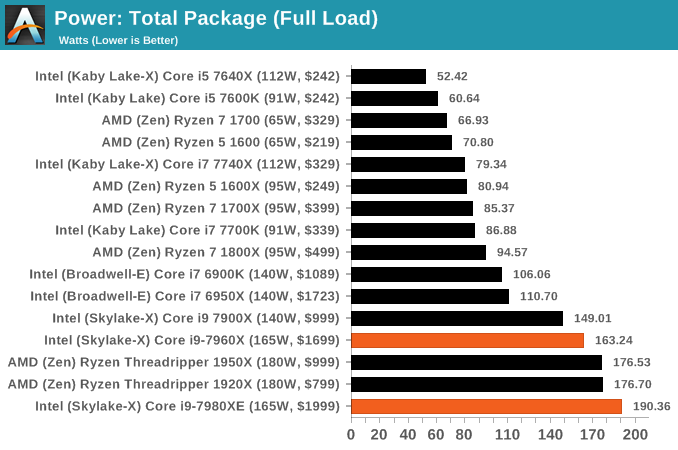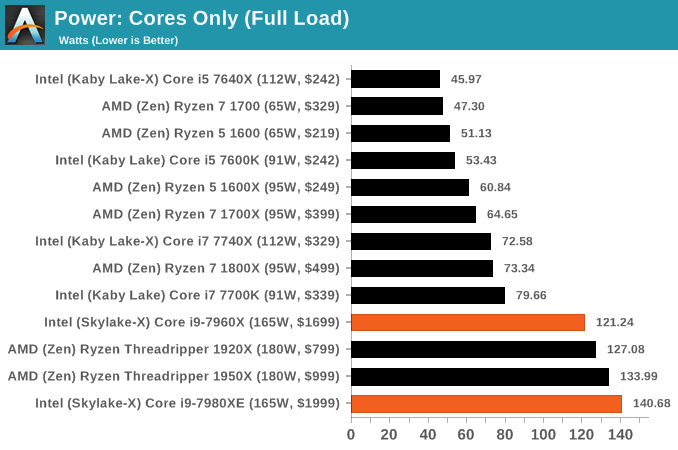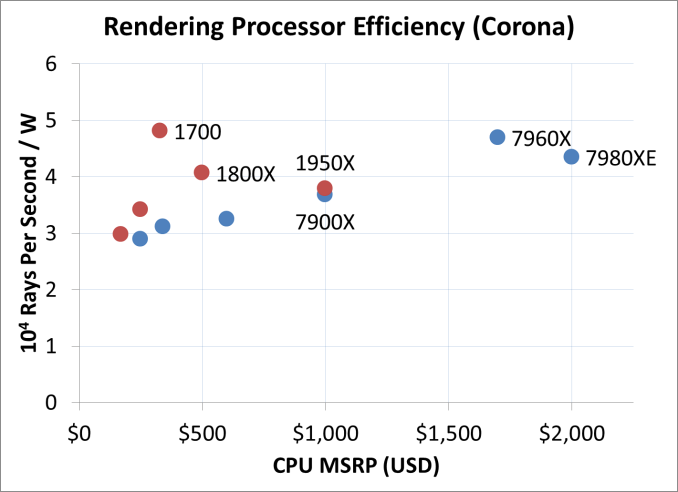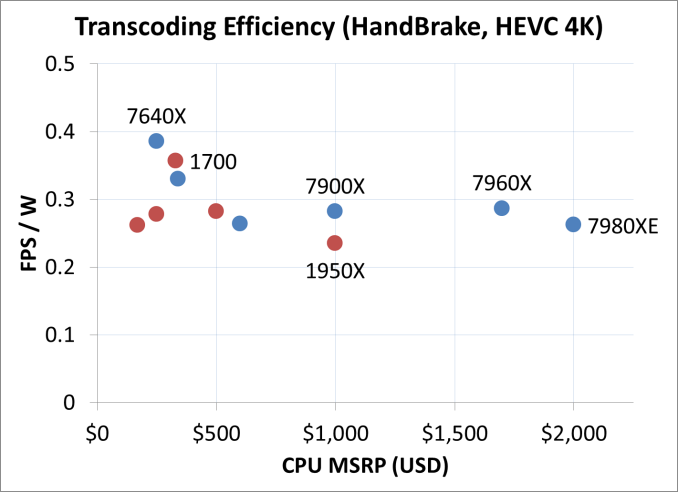The Intel Core i9-7980XE and Core i9-7960X CPU Review Part 1: Workstation
by Ian Cutress on September 25, 2017 3:01 AM ESTA Few Words on Power Consumption
When we tested the first wave of Skylake-X processors, one of the take away points was that Intel was starting to push the blurred line between thermal design power (TDP) and power consumption. Technically the TDP is a value, in Watts, to which a CPU cooler should be designed to cope with heat energy of that amount: a processor with a 140W TDP should be paired with a CPU cooler that can dissipate a minimum of 140W in order to avoid temperature spikes and ‘thermal runaway’. Failure to do so will cause the processor to hit thermal limits and reduce performance to compensate. Normally the TDP is, on average, also a good metric for power consumption values. A processor with a TDP of 140W should, in general, consume 140W of power (plus some efficiency losses).
In the past, particularly with mainstream processors, and even with the latest batch of mainstream processors, Intel typically rides the power consumption well under the rated TDP value. The Core i5-7600K for example has a TDP of 95W, and we measured a power consumption of ~61W, of which ~53W was from the CPU cores. So when we say that in the past Intel has been conservative with the TDP value, this is typically the sort of metric we will quote.
With the initial Skylake-X launch, things were a little different. Due to the high all-core frequencies, the new mesh topology, the advent of AVX-512, and the sheer number of cores in play, the power consumption was matching the TDP and even exceeding it in some cases. The Core i9-7900X is rated at 140W TDP, however we measured 149W, a 6.4% difference. The previous generation 10-core, the Core i7-6950X was also rated at 140W, but only draws 111W at load. Intel’s power strategy has changed with Skylake-X, particularly as we ramp up the number of cores.
Even though we didn’t perform the testing ourselves, our colleagues over at Tom’s Hardware, Paul Alcorn and Igor Wallossek, did extensive power testing on the Skylake-X processors. Along with showing that the power delivery system of the new motherboards works best with substantial heatsinks and active cooling (such as a VRM fan), they showed that with the right overclock, a user can draw over 330W without too much fuss.
So for the two processors in the review today, the same high values ring true. Almost to the point of it being alarmingly so. Both the Core i9-7980XE and the Core i9-7960X have a TDP rating of 165W, and we start with the peak headline numbers first. Our power testing implements a Prime95 stress test, with the data taken from the internal power management registers that the hardware uses to manage power delivery and frequency response. This method is not as accurate as a physical measurement, but is more universal, it removes the need to tool up every single product, and the hardware itself uses these values to make decisions about the performance response.

At full load, the total package power consumption for the Core i9-7960X is almost on the money, drawing 163W.
However the Core i9-7980XE goes above and beyond (and not necessarily in a good way). At full load, running an all-core frequency of 3.4 GHz, we recorded a total package power consumption of 190.36W. This is a 25W increase over the TDP value, or a 15.4% gain. Assuming our singular CPU is ‘representative’, I’d hazard a guess and say that the TDP value of this processor should be nearer 190W, or 205W to be on the safe side. Unfortunately, when Intel started designing the Basin Falls platform, it only was designed to be rated at 165W. This is a case of Intel pushing the margins, perhaps a little too far for some. It will be interesting to get the Xeon-W processors in for equivalent testing.
Our power testing program can also pull out a breakdown of the power consumption, depending if the registers are preconfigured in the software. In this case we were also able to pull out values for the DRAM controller(s) power consumption, although looking at the values this is likely to include the uncore/mesh as well. For both CPUs at load, we see that this DRAM and mesh combination is drawing ~42W. If we remove this from the load power numbers, that leaves 121W for the 16-core chip (7.5W per core) and 140W for the 18-core chip (7.8W per core).

Most of the rise of the power consumption, for both the cores and DRAM, happens when the processor is loaded to four threads - the Core i9-7980XE is drawing 100W+ when four threads are loaded. This is what we expect to see: when the processor is lightly loaded and in turbo mode, a core can consume upwards of 20W, while at load it will migrate down to a smaller value. We saw the same with with Ryzen, drawing 17W per core when lightly threaded down to 6W per core when loaded. Obviously the peak efficiency point for these cores is down nearer the 6-8W range than up at the 15-20W range.
Unfortunately, due to timing, we did not perform any overclocking to see the effect it has on power. There was one number in the review materials we received that will likely be checked with our other Purch colleagues: one motherboard vendor quoted the power consumption of the Core i9-7980XE, when overclocked to 4.4 GHz, will reach over 500W. I think someone wants IBM’s record. It also means that the choice of CPU cooler is an important factor in all of this: very few off-the-shelf solutions will happily deal with 300W properly, let alone 500W. These processors are unlikely to bring about a boom in custom liquid cooling loops, however for the professionals that want all the cores and also peak single thread performance, start looking at pre-built overclocked systems that emphasize a massive amount of cooling capability.
A Quick Run on Efficiency
Some of our readers have requested a look into some efficiency numbers. We’re still in the process of producing a good way to represent this data, and take power numbers directly during the benchmark to get a full accurate reading. In the meantime, we’re going to take a benchmark we know hammers every thread of every CPU and put that against our load power readings.
First up is Corona. We take the benchmark result and divide by the load power, to get the efficiency value. This value is then reduced by a constant factor to provide a single digit number.
In a rendering task like Corona, where all the threads are hammered all the time, both the Skylake-X parts out-perform Threadripper for power efficiency, although not by twice as much. Interestingly the results show that as we reduce the clocks on TR, the 1700 comes out on top for pure efficiency in this test.
HandBrake’s HEVC efficiency with large frames actually peaks with the Core i5 here, with the 1700 not far behind. All the Skylake-X processors out-perform Threadripper on efficiency.












152 Comments
View All Comments
ddriver - Monday, September 25, 2017 - link
Don't worry, they get plenty of support from the big boys for all those shamelessly biassed reviews. And don't act like your pennies will go to feed someone's starving children. So yeah, uBlock FTW.pedrostee - Monday, September 25, 2017 - link
just curious but do you have any evidence, even a small bit, to support your claim that “they get plenty of support from the big boys for all those...”i think it is possible, and you seem a man of science - evidence can support any statement no matter how outlandish — so please present such if you would.
thnks
ddriver - Monday, September 25, 2017 - link
Obvious stuff is obvious, as are you ;) Nice try thou. Are you the one who is going to pay for evidence searching investigation? I personally don't feel like obvious things need evidence, but if you do, go ahead and investigate.ddriver - Monday, September 25, 2017 - link
But the ugliest part is intel went cheap even on a 2000$ CPU, taking a literal dump on it by going for the same old lousy TIM implementation.After this reveal from intel, TR looks even better than it did before.
Notmyusualid - Monday, September 25, 2017 - link
@ pedrosteeIt seems you've finally met the 'village idi0t'. He will provide no evidence, as you likely expected, and we have to endure his bizarre views on ever major article.
Reflex - Monday, September 25, 2017 - link
He's 2017's version of LordRaiden from around 2004 in these forums. Knows just enough to sound knowledgeable to those not in the industry, but is incapable of supporting his assertions because he is running on the theory that if he believes it in his mind it must be true.Look up LordRaiden in the AT forums if you want to see when this last happened.
mkaibear - Monday, September 25, 2017 - link
Yeah, it's hilarious. Anyone who's actually in the IT industry knows he's talking out of his lower orifices and it's always funny to watch him huff about like anyone actually takes him seriously.It's like the cat tax. No article is complete without a good laugh at ddriver.
Reflex - Monday, September 25, 2017 - link
It is unfortunate however because he often derails actually interesting conversations.ddriver - Monday, September 25, 2017 - link
Oh wow, the fanclub is sure gradually moving down, and just when it seemed it already hit the bottom. But hey, if pretending that you are not a completely clueless wannabes works for you, by all means, know yourselves out :)ddriver - Monday, September 25, 2017 - link
You know, I complete agree, however you have mistyped "lame suckers" and typed "IT industry" instead.Here is a hint - you cannot take seriously that which you don't have the capacity to understand. Your "best" boils down to clapping and cheering at the mainstream mediocrity to cultivate the illusion that you are smart. And when someone comes along and tears that illusion down, you are sore to realize the reality about you. And you are only left with denial in the form of those pathetically anemic attempts at intimidation through ridicule. But suckers will be suckers, and as suck, always failing to make a valid argument in their favor :)